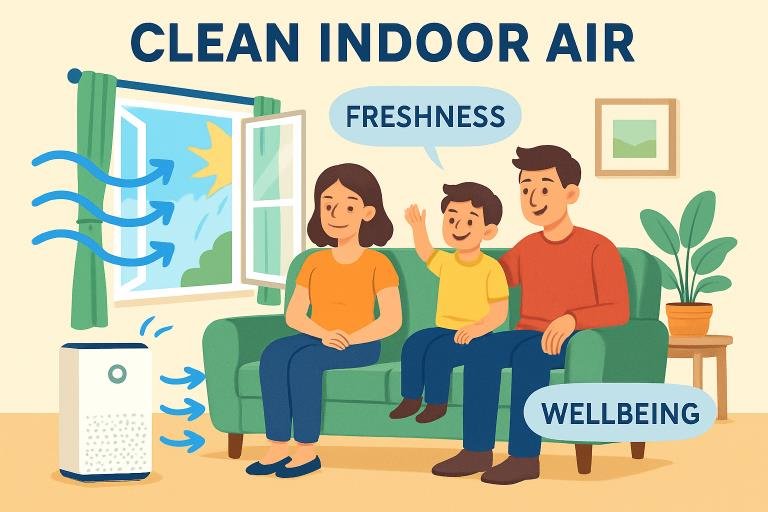Key Takeaways
- The significance of indoor air quality for both health and productivity.
- Effective solutions range from advanced ventilation and filtration to smarter monitoring systems.
- Innovative building materials and tailored technologies can drastically reduce indoor pollutants.
- Real-time smart monitoring enables proactive management of indoor conditions.
Indoor air quality (IAQ) plays a crucial yet often underestimated role in overall health and productivity. With people spending nearly 90% of their lives indoors, the quality of the air we breathe, both at home and at work, directly impacts our well-being. Ensuring high IAQ entails more than just regular cleaning—it calls for specialized strategies and advanced solutions. Taking proactive steps is essential, and working with trusted experts, such as the Clean Air Company, can help transform indoor spaces into safe and refreshing environments for all occupants.
Pollutants like volatile organic compounds (VOCs), mold spores, and fine particulate matter can enter indoor air from outside or even from household products and building materials. These hidden hazards may contribute to respiratory ailments, allergic reactions, and overall discomfort. Addressing them requires a multidimensional approach, blending upgraded building systems, smarter technologies, and safer materials.
Through a mix of proper ventilation, effective filtration, and sustainable innovations, it is possible to safeguard against pollutants and maintain optimal air quality year-round. This comprehensive approach not only protects health but also creates more comfortable and productive indoor environments, supporting improved focus and well-being for everyone.
Understanding Indoor Air Quality
IAQ refers to the state of the air inside buildings, as it affects the health, comfort, and safety of occupants. Major indoor air contaminants include VOCs (emitted by cleaning agents and paints), biological allergens such as mold and dust mites, and potentially harmful gases like carbon monoxide. Poor IAQ can result in both acute and chronic health conditions, from headaches and fatigue to more serious issues like asthma and other respiratory ailments. According to the U.S. Environmental Protection Agency, long-term exposure to indoor air pollution can sometimes be even riskier than similar exposure outdoors. For a natural and effective way to improve indoor air quality, consider consulting with directions to Clean Air Company, which specializes in eco-friendly air purification solutions that help remove pollutants without introducing additional chemicals into your environment.
Effective Ventilation and Filtration
Ventilation is the process of exchanging indoor air with outdoor air, helping to dilute and remove indoor air contaminants. Mechanical ventilation, particularly with Energy Recovery Ventilators (ERVs) and Heat Recovery Ventilators (HRVs), brings in fresh outdoor air while reducing pollutant levels and optimizing energy use. These systems have revolutionized modern indoor environments, enabling continuous fresh airflow with minimal heat loss and reduced energy bills. For airborne particles and chemical pollutants, HEPA filters in HVAC systems are highly effective in removing them. These advanced filters capture upwards of 99.97% of airborne particulates, including those as small as 0.3 microns, thereby improving respiratory health and reducing allergens.
Innovative Building Materials
Standard building materials often release hazardous VOCs over time, contributing to poor IAQ. Forward-thinking manufacturers have addressed this by introducing low-emission or zero-VOC products. Notably, Knauf Insulation’s ECOSE Technology utilizes a formaldehyde-free, bio-based binder, setting a new standard for insulation products and reducing toxic emissions indoors. This class of materials, including paints, flooring, and adhesives, helps ensure that indoor spaces remain safe for vulnerable groups, such as children, seniors, and individuals with chronic illnesses.
Smart Monitoring Systems
Modern indoor air quality management extends beyond passive prevention. Smart monitoring systems, leveraging a wide array of sensors, now provide real-time feedback on pollutant levels, temperature, humidity, and even occupant activities. Recent advances in AI-powered solutions, such as deep learning with 1D Convolutional Neural Networks (1D-CNNs), have enabled these systems to detect and categorize changes in air quality rapidly. With data-driven insights, homeowners and facility managers can respond to emerging threats immediately, adjusting HVAC settings or activating filtration systems to maintain optimal conditions.
Addressing Specific Challenges
Indoor air quality can fluctuate due to external events or environmental conditions. For example, during wildfire events, air laden with particulate matter can infiltrate even well-sealed buildings, dramatically degrading IAQ in a matter of hours. Innovative solutions, such as those offered by Carrier Global Corporation, help mitigate these risks with advanced filtration and pressurization techniques. Custom strategies are essential, particularly for people living near major wildfires, urban smog, or in older homes prone to moisture and mold growth. The Centers for Disease Control and Prevention offers recommendations for preparing buildings during wildfire season and other air quality emergencies.
Implementing IAQ Solutions
- Begin by conducting an assessment using smart air quality monitors to identify current problem areas and track improvements over time.
- Upgrade existing ventilation systems to incorporate energy-efficient ERVs or HRVs that continually cycle in fresh, conditioned air.
- Opt for low-VOC and formaldehyde-free building materials during renovations or new construction projects for sustainable, long-term IAQ improvement.
- Install or retrofit HVAC systems with high-performance air filters, like HEPA models, which significantly reduce allergens and particulate matter.
- Maintain all purification and ventilation systems regularly to ensure peak efficiency and reliability, minimizing future risks.
Conclusion
Prioritizing indoor air quality pays dividends in terms of health, comfort, and productivity, especially as the modern lifestyle increasingly keeps people indoors. Through diligent upgrades to building systems, strategic material choices, and the use of real-time monitoring technologies, homeowners and businesses can successfully combat indoor pollutants and enjoy healthier living spaces year-round. By taking a proactive stance in addressing IAQ, today’s indoor environments can become safer, more comfortable, and ultimately, far more nutritious for everyone who lives or works there.



